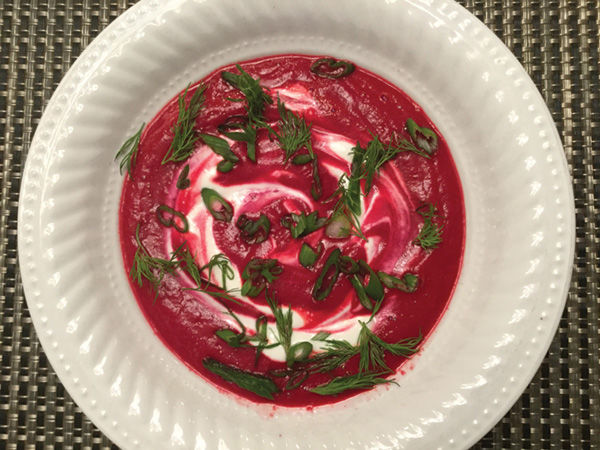Vegging out: Inspired recipes that skip the meat
Published February 15, 2017
I recently presented a unique cooking demonstration to a gathering at Crown Center in University City. What made it unique was a remarkably contemporary vegetarian cookbook dating back before World War II. That book, originally written in Yiddish and published in 1938 under the title “Vegetarish-Dietisher Kokhbukh,” has now been republished in English under the title “The Vilna Vegetarian Cookbook.”
The cookbook’s author, Fania Lewando, was a genuine (but long forgotten) culinary pioneer. She lived in Vilna, Lithuania from the mid 1920s until she was killed in 1941 while attempting to escape from the Vilna Ghetto.
Lewando ran both a kosher vegetarian restaurant and a cooking school in Vilna. She emphasized the importance of cooking with vegetables at their peak to maximize both flavor and nutrition. She also developed recipes for incorporating grains, beans and dairy into daily meals, explaining that all of the vitamins, minerals and protein needed to maintain good health could be fully accessed without ever needing to consume meat, fish or chicken.
ADVERTISEMENT
As you can probably tell, many of Lewando’s maxims and beliefs from the 1930s are the ones now being promoted by today’s culinary and nutritional experts. These include the farm-to-table credo of Alice Waters, Michael Pollan’s emphasis on fresh fruits and vegetables over processed canned foods, and the commitment to using every part of a fruit or vegetable in your recipes — a commitment advocated by a culinary Who’s Who that includes Dan Barber, April Bloomfield and Steven Satterfield.
Lewando’s cookbook includes an essay (originally in Yiddish) by one Ben-Zion Kit, who offers three arguments to support her vegetarian lifestyle: the ability of mammals living in the wild to subsist only on plants; projected population growth that would eventually make a diet that relied on meat unsustainable; and a biblical perspective, for which he sites a passage from Genesis 1:29: “And God said, ‘I give you all seed-bearing grasses that grow on the earth and all trees that bear fruit and this shall be for you to eat.’ ”
In her cookbook, Lewando offers practical advice to cooks, along with nutritional information for a variety of fruits and vegetables. Her recipes are brief and easy to follow and generally produce healthy and hearty fare to satisfy even the pickiest eaters. (Warning: many of her recipes include copious amounts of butter and sour cream. In some cases, the recipes can be made using less butter and sour cream; alternatively, you could use olive oil in place of butter and yogurt in place of sour cream.)
ADVERTISEMENT
So how do Lewando’s vegetarian recommendations resonate in 2017? Quite well. For starters, there is a diverse cornucopia of fresh vegetables and fruits available year-round in grocery stores and at farmer’s markets. Furthermore, we are in the midst of an exciting culinary renaissance. Young chefs and home cooks are creating and sharing innovative recipes for delicious vegetarian food. These days, virtually every restaurant offers vegetarian options. Moreover, hundreds of new restaurants echoing Lewando’s 100 percent vegetarian credo are opening across the country.
After reading through “The Vilna Kosher Vegetarian Cookbook,” I prepared a week of vegetarian meals. I used many of Lewando’s recipes, created some of my own and used recipes created and posted by our daughter Kayla on her mostly vegetarian cooking blog, The Minimalist Pantry (minimalistpantry.com). At the conclusion of that week, my husband Mike and I agreed that we hadn’t missed meat.
While transitioning to a vegetarian diet may take some time, we can easily incorporate more healthy vegetable, fruit and grain dishes into our meals. Think about it: there are food cultures around the world, such as Asian and Mediterranean cuisines, where diets based on grains, pasta, bread, and rich in vegetables and fruit are the norm. Interestingly, those populations have a lower incidence of heart disease and obesity. I am not a nutritionist so I will let you draw your own conclusions.
One word of caution: adhering to a vegetarian diet does not mean that everything you eat is good for you. While a diet rich in grains, beans, dairy, vegetables and fruits is certainly healthy, eating foods high in sugar, or those made exclusively with white flour, are not. My theory on whatever dietary plan you follow: everything in moderation, and desserts only occasionally.
So I encourage you to explore all of the new and thrilling ways to prepare vegetables: raw, steamed, roasted, sautéed and stewed. Serve those vegetables on or with a variety of grains: brown rice, faro, quinoa, polenta, pasta, corn tortillas, potato and squash purees, spiralized vegetable noodles or even faux rice made from ground raw cauliflower. If someone in your family thinks that vegetables are unappetizing and unexciting, you can easily prove them wrong. Vegetables also span the colors of the rainbow, and the combinations are not only delicious, but also appealing to the eye. That is, by the way, how you first “taste” your food.
Finally, make time to really enjoy your meals, be it alone or with family and friends.
Margi Lenga Kahn is the mother of five and grandmother of five. A cooking instructor at the Kitchen Conservatory, she is currently working on a project to preserve the stories and recipes of heritage cooks. She welcomes your comments and suggestions at [email protected].















